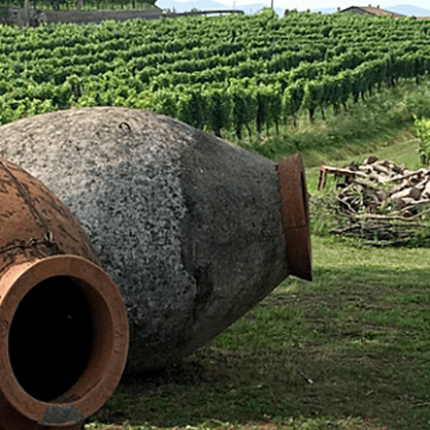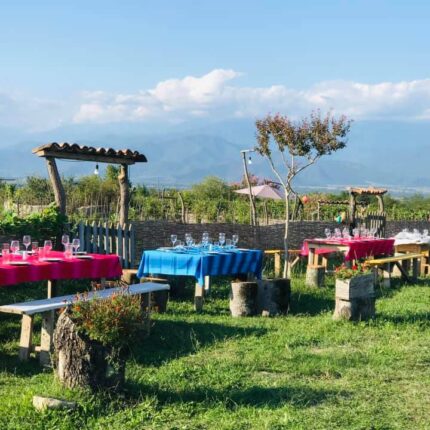Georgia is at the crossroads of civilizations, with the Black Sea to the west and nestled in the Caucasus Mountains. Throughout centuries, the culture and the indigenous population have been shaped by various conquerors and the Great Silk Road merchants. Georgia is a country where guests are ‘a gift from God’; where tourists are welcomed with warm hearts, hosted at delightful Georgian feasts (Supras), and blessed by a ‘tamada’ with a glass of fine local wine, all accompanied by unique pieces of Georgian polyphonic music.
In November 2017, a study by researchers from the University of Toronto and the Georgian National Museum declared that the residual wine compounds found in two sites south of Tbilisi dated as far back as 5980 BC.

It is the earliest-known evidence of winemaking – dating back some 8,000 years. No wonder wine is such an integral part of Georgian culture.
Vine cultivation is a delicate process, since even small changes in climate, environment, or care may affect the sweetness of the residual sugar in grapes, and thus affect the wine. Georgia’s location on the border of temperate and subtropical zones is optimal for wine-making. Summers are warm enough for the grapes to attain the necessary sugar-levels, while winters are not so harsh as to damage the vines. The moist air of the Black Sea, pure mountain springs, and natural groundwater systems infuse the mineral-rich soil around the valleys.
There are six viticulture areas in Georgia: Kakheti, Kartli, Meskheti, Imereti, Racha-Lechkhumi and the Black Sea coast. Unofficially, wine is fermented all across the country, with significant fluctuations in quality. Kakheti is the leading winemaking region, where peaty, black, and silty soils dominate. Among traditional Kakhetian wine varieties like Saperavi, Rkatsiteli, and Mukuzani, one may find the originally-French Cabernet Sauvignon, which has perfectly adapted to the regional microclimate. Imereti is known for its diversity among the micro zones, resulting in numerous varieties of wine, including Tsolikouri, Tsitska and Adanasuri. Kartli, where the world’s oldest wine was fermented, is known for high-quality sparkling wines. Out of roughly 4,000 vine-species known in the world today, 525 (13%) are endemically Georgian. It is believed that a few centuries ago, that number was 1,400.
Georgia is the guardian of ancient winemaking traditions. Recent discoveries confirmed the early existence of the Qvevri method. The Qvevri is a roughly-egg-shaped clay vessel, buried in the ground during grape fermentation. It is built unhurriedly, with the circular layers taking into account the clay’s humidity and ensuring uniform drying. Qvevri-maker is an unusual profession, only shared within family lines. Not only is the mathematical knowledge of the proportions inherited, but also apparently the mystic intuition and centuries-long experience. In 2013, the Qvevri method of winemaking was added to the Representative List of the Intangible Cultural Heritage of Humanity by UNESCO.

Both types of traditional winemaking existing in the country – the Kakhetian and European (Imeretian) – are based on the Qvevri method. Everything starts with ‘Rtveli’, the grape harvest. Every Rtveli is completed with a ‘supra’. After grapes are collected, they are put into ‘Satsnakheli’, an elongated wooden vessel, where the wine-maker presses the grapes with his feet. The Kakhetian rule requires that the juice, seeds, grape skins, sprouts, and branches are all fermented together in Qvevri. The European rule indicates that the only the juice should be fermented in the Qvevri.
Linguistic research claims the word ‘wine’ and its European varieties (Vin – French, Vino – Spanish), originated from the Georgian word ‘Gvino’. After the recent archaeological discovery, this idea seems to be widely accepted, since the product and its name would probably have been originated in the same place.
In Georgia, wine is a synonym of life, with each glass containing much more happiness and flavor, than life itself.



